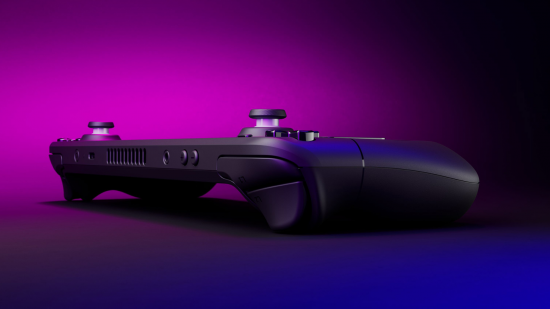It’s no secret that we here at Pocket Tactics love gaming on the go. The latest handheld games consoles offer a wealth and breadth of games to be played, whether you’re traveling or at home on sitting on the sofa. Handheld PCs are a relatively new addition to the portable console industry, allowing us to take even more of our favorite games – especially via emulation – with us on the go. And we’re never going to say no to more games, are we?
Valve’s affordable Steam Deck was launched last year and made its way onto our list of the best portable gaming consoles. It blew the lid off what was previously a middling Kickstarter-backed handheld world and we’ve loved pushing it and prodding it to see how far it can go. We even called it a “breakthrough in portable PC gaming” in our Steam Deck review. However, time never stops and more recent AAA games have been a bridge too far for the Deck, setting the stage for a true successor.
The recently launched Asus ROG Ally set out to be a true rival for the Steam Deck, and as it turns out, it’s a compelling opponent. Does the ROG Ally do enough to steer you away from Valve and their triumphant Deck? If you’re wondering whether to buy the Steam Deck vs Asus RoOG Ally, we’ll here to help you to make an informed buying decision.
Asus ROG Ally vs Steam Deck Specs
Here are the ROG Ally vs Steam Deck specs:
| Asus ROG Ally | Steam Deck | |
| APU | AMD Ryzen Z1 Extreme |
AMD Van Gogh |
| Cores/Threads | 8/16 | 4/8 |
| Graphics | 12 RDNA 3 CUs |
8 RDNA 2 CUs |
| RAM | 16GB LPDDR5 6400 MT/s dual channel |
16GB LPDDR5 5500 MT/s quad channel |
| Display | 7-inch IPS 1080p/120Hz VRR |
7-inch IPS 800p/40-60Hz (fixed) |
| Storage | 512GB PCIe 4.0 SSD / microSD 608g |
64GB eMMC, 256GB or 512GB PCIe 3.0 SSD |
| Weight | 608g |
669g |
| OS | Windows 11 |
SteamOS |
| Price | $699 / £699 |
$399 / £349 (64GB) $529 / £459 (256GB) $649 / £569 (512GB) |
Asus ROG Ally vs Steam Deck Design
Both the Asus ROG Ally and Steam Deck are made from plastic. They’re a similar weight, at 608g and 669g respectively, and both have 7-inch screens (however the ROG Ally offers 120Hz over 40-60Hz).
Asus has clearly pandered to us nerds with the stylish gamer aesthetic of the ROG Ally. We’re not ones to turn our nose up at customizable RGB lighting and the white design really is something to behold. The jury is out on how well the white will hold up after hours of gameplay.
The Steam Deck is the more utilitarian of the two. Don’t get us wrong, we’re rather fond of its no-nonsense looks and it holds up really well to the perils faced by a portable machine. If you really can’t stand the look of the Deck, there is an absolute plethora of skins and cases to customize it to your liking.
Asus ROG Ally vs Steam Deck Handling
A slight letdown for the ROG Ally is the smaller grips making it a little harder to handle but it is still plenty comfortable, especially with the lighter weight. The asymmetrical joystick layout really stands out here too making it feel a bit more natural in the hand. Using the ROG Ally under a normal gaming load, we found it to be a lot quieter too.
Playing in the Deck’s favor are its supple grips with so much real estate your local council might just build student accommodation on top of it. While functionally great the trackpads do make the joystick layout a little more awkward in our opinion. The Deck is also quite literally loud and proud so you might find yourself having to play less intensive games when amongst company.
Asus ROG Ally vs Steam Deck Features
Long story short: The ROG Ally is significantly more powerful with its AMD Z1 Extreme APU. Making use of all that horsepower is a lovely screen. It’s faster, sharper, brighter, more vivid, and importantly smoother than the Deck’s.
The variable refresh rate smooths out the kinks from those dropped frames and avoids the hassle of trying to optimize your settings perfectly for a set target. Just set the graphics to your liking and go.
And as if the deal wasn’t sweet enough already, Asus is bundling 3 months of Xbox Game Pass for good measure.
The Deck absolutely does hold its own and is by no means a slouch so don’t eschew it, there is more to gaming than raw performance after all.
It also has an advantage in screen real estate. The screen is slightly taller despite its lower resolution so the screen certainly appears larger despite being a little fuzzier. It also means that framerates can be broadly similar when compared to the ROG Ally due to the lower target resolution.
Also included are trackpads which enable much more precise control for your 360 no-scopes when paired with the gyro controls. They’re also great for strategy games and navigating the desktop environment.
Battery life between the two is broadly similar with no clear winner either way so you can expect to play your games away from the plug for the same amount of time. A fast charger is included with the ROG Ally so your time plugged in will be much less unless you already have a third-party charger for the Deck.
Asus ROG Ally vs Steam Deck Games
Without a doubt, the ROG Ally has a bigger library. This is because it runs Windows 11 rather than the Deck’s Linux-derived SteamOS. Certain games such as Fortnite and Roblox do not play nice with SteamOS and unless you have the know-how to install Windows on the Deck you are outta luck.
A few outliers withstanding though, the Deck can play pretty much any game thrown at it and you can be guaranteed a great experience when choosing games through Valve’s Deck Verified program. It takes a whole lot of the guesswork out and lets you dive straight in.
The Deck also benefits from a massive community and emulators that have been tailored to work really well on the Deck’s hardware. What unites these two consoles is how comparably cheap PC games are compared to the Nintendo Switch console lineup (although there are plenty of free Switch games). Though the upfront cost might be higher for both, over the long term you may even save.
Asus ROG Ally vs Steam Deck Price
The Asus ROG Ally retails for $699 (£699) and is available for pre-order at Best Buy starting May 11. In the UK you can pre-order it from Asus directly. The Asus ROG Ally will be released on June 13 with shipping expected to take 2 to 3 days.
The Steam Deck is available in three SKUs, 64GB, 256GB, and 512GB for $399 (£349), $529 (£459), or $649 (£569) respectively through Valve.
In the US you can expect your Deck within 1 to 2 weeks time, while in the UK Steam currently lists the 64GB and 256GB models as out of stock with the 512GB model taking the same one to two weeks to reach your door.

Should you buy the Steam Deck?
If you feel confident upgrading the storage yourself, the 64GB Steam Deck model offers a heck of a lot of performance for a lot less money. The trackpads open up a lot more options for different kinds of games, especially strategy and classic PC titles.
The platform offers endless customizability and has the backing of huge parts and accessories aftermarket to make your Deck truly unique. The cracks are beginning to show however and the Deck is struggling to keep up with the latest games. If this is important to you, perhaps your money is better spent on a different portable gaming console.
Should you buy the Asus ROG Ally?
The ROG Ally is expensive and can be harder to recommend if you didn’t want the 512GB model of the Deck. You may also find yourself struggling with strategy and older games that don’t play nice with its controllers.
However, if maximum performance is a priority for you then the ROG Ally could be perfect for you. Its AMD Ryzen Z1 Extreme APU, Its all bells and whistles specs ensure you’re going to have a smooth, fast, and sharper experience. With its greater compatibility, including with the Xbox (PC) Game Pass, you won’t be missing out on any of your favorite games or be left wanting extra power with newer titles.


